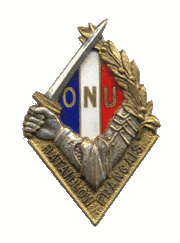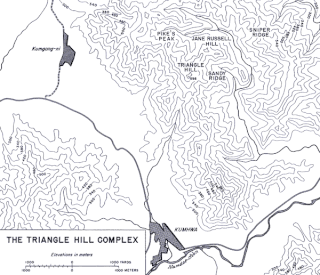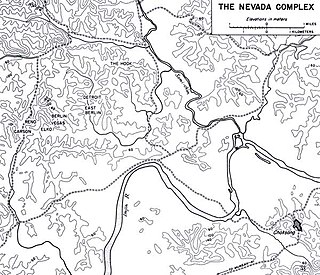
The Battle of the Imjin River, also known as the Battle of Solma-ri or Battle of Gloster Hill in South Korea, or as Battle of Xuemali in China, took place 22–25 April 1951 during the Korean War. Troops from the Chinese People's Volunteer Army (PVA) attacked United Nations Command (UN) positions on the lower Imjin River in an attempt to achieve a breakthrough and recapture the South Korean capital Seoul. The attack was part of the Chinese Spring Offensive, the aim of which was to regain the initiative on the battlefield after a series of successful UN counter-offensives in January–March 1951 had allowed UN forces to establish themselves beyond the 38th Parallel at the Kansas Line.

The Battle of Pork Chop Hill, known as Battle of Seokhyeon-dong Northern Hill in China, is a pair of related Korean War infantry battles in April 16 and July 11, 1953 while the United Nations Command (UN) and the Chinese and North Koreans were negotiating the Korean Armistice Agreement.
The Battle of Yultong, also known as the Battle of Puluodong, Battle of Yuldong, or Battle of Yuldong-ri, took place during the Korean War. It was fought between elements of the Chinese People's Volunteer Army (PVA) 34th Division and the Filipino 10th Battalion Combat Team (BCT), north of Yeoncheon during April 22–23, 1951. The battle was part of the Chinese Spring Offensive.

The Battle of Hill Eerie refers to several Korean War engagements between the United Nations Command (UN) forces and the Chinese People's Volunteer Army (PVA) in 1952 at Hill Eerie, a military outpost about 10 miles (16 km) west of Ch'orwon. It was taken several times by both sides; each sabotaging the others' position.

The French Battalion of the United Nations Organisation was a battalion of volunteers made up of active and reserve French military personnel sent to the Korean Peninsula as part of the UN force fighting in the Korean War.
Étienne Gailly was a Belgian soldier and Olympic athlete who competed mainly in the Marathon.

Outpost Harry was a remote Korean War outpost located on a tiny hilltop in what was commonly referred to as the "Iron Triangle" on the Korean Peninsula. This was an area approximately 60 miles (100 km) northeast of Seoul and was the most direct route to the South Korean capital.

The Battle of Triangle Hill, also known as Operation Showdown or the Shangganling Campaign, was a protracted military engagement during the Korean War. The main combatants were two United Nations (UN) infantry divisions, with additional support from the United States Air Force, against elements of the Chinese People's Volunteer Army (PVA) 15th and 12th Corps. The battle was part of UN attempts to gain control of the "Iron Triangle" and took place from 14 October to 25 November 1952.

The Battle of the Samichon River was fought during the final days of the Korean War between United Nations (UN) forces—primarily Australian and American—and the Chinese People's Volunteer Army (PVA). The fighting took place on a key position on the Jamestown Line known as "the Hook", and resulted in the defending UN troops, including the 2nd Battalion, Royal Australian Regiment from the 28th British Commonwealth Brigade and the US 7th Marine Regiment, repulsing numerous assaults by the PVA 137th Division during two concerted night attacks, inflicting numerous casualties on the PVA with heavy artillery and small-arms fire. The action was part of a larger, division-sized PVA attack against the US 1st Marine Division, with diversionary assaults mounted against the Australians. With the peace talks in Panmunjom reaching a conclusion, the Chinese had been eager to gain a last-minute victory over the UN forces, and the battle was the last of the war before the official signing of the Korean armistice.

The Battle of Uijeongbu, also known as the Battle of Uijongbu, was fought between 1 and 4 January 1951, at Uijeongbu, South Korea, as part of the United Nations Command (UN) retreat after the third Chinese People's Volunteer Army (PVA) offensive after entering the Korean War. The 3rd Battalion, Royal Australian Regiment had been defending the approaches north of Seoul, as part of the withdrawal of the United Nations forces and tasked with slowing the Chinese advance to allow the withdrawal of the United States 8th Army.

The Volunteer Corps for Korea was a Belgium–Luxembourg military force sent to assist South Korea during the Korean War. A battalion-sized unit, it arrived in Korea in 1951 and remained after the cease-fire until 1955. Over the course of its existence, 3,171 Belgians and 78 Luxembourgers served in the unit.
The Battle of Haktang-ni was a skirmish in which elements of the People's Volunteer Army attacked an advanced position held by the Belgium–Luxembourg Battalion along a ridge-line known as "Broken Arrow" or "Broken Arrow Hill" between 9 and 13 October 1951.

The Kingdom of Thailand was one of the 21 countries who responded to the United Nations request to send troops to aid South Korea during the Korean War 1950–1953. As well as being one of the first countries to openly express its support for South Korea's cause, whilst also being one of the UN's larger contributors to the war. Thai support was important to battles determining the outcome of the war, such as the Third Battle of Seoul.

The battle for Outpost Vegas was a battle during the Korean War between the armed forces of the United Nations Command (UN) and China from 26 to 30 March 1953, four months before the end of the Korean War. Vegas was one of three outposts called the Nevada Cities north of the Main Line of Resistance (MLR), the United Nations defensive line which stretched roughly around the latitude 38th Parallel. Vegas, and the outposts it supported, Reno and Carson, were manned by elements of the 1st Marine Division. On 26 March 1953 the Chinese People's Volunteer Army (PVA) launched an attack on the Nevada Cities, including Vegas, in an attempt to better the position of China and North Korea in the Panmunjon peace talks which were occurring at the time, and to gain more territory for North Korea when its borders would be solidified. The battle raged for five days until PVA forces halted their advance after capturing one outpost north of the MLR on 30 March, but were repelled from Vegas. The battle for Outpost Vegas and the surrounding outposts are considered the bloodiest fighting to date in western Korea during the Korean War. It is estimated that there were over 1,000 American casualties and twice that number of Chinese during the Battle for Outpost Vegas. The battle is also known for the involvement of Sergeant Reckless, a horse in a USMC recoilless rifle platoon who transported ammunition and the wounded during the U.S. defense of outpost Vegas.
Lieutenant-General Baron Albert Crahay was a Belgian soldier and historian. He is known particularly as the commander of the Belgian contingent in the Korean War and of the Belgian army of occupation in Germany.

The Battle of the Nevada Complex was a battle fought between 25 and 29 May 1953 during the Korean War between United Nations Command (UN) and Chinese forces over several front line outposts. After suffering heavy losses the UN abandoned the positions.
The Battle of Jackson Heights was a battle fought between 16 and 29 October 1952 during the Korean War between United Nations Command (UN) and Chinese forces for possession of a UN outpost position. The Chinese successfully seized the position and defended it against UN counterattacks.

The Battle of the Berlin Outposts and Bunker City was a battle fought between 7 and 27 July 1953 during the Korean War between United Nations Command (UN) and Chinese forces over several frontline outposts.

In support of the United Nations Command, Luxembourg sent 110 troops to fight in Korea. Of these, 2 died and 17 were injured. Luxembourg decided to ally with the Belgians and form 1st Platoon A Company, and with the Belgians arrived in Korea on 31 January 1951. Many Luxembourgers decided to join the Belgian Volunteer Corps for Korea. Luxembourg would fight at Imjin River, Haktang-ni, and Chatkol. Luxembourg contributed a 44-man rifle regiment called the Royal Luxembourg Regiment. The Luxembourgers left Korea in January 1953










